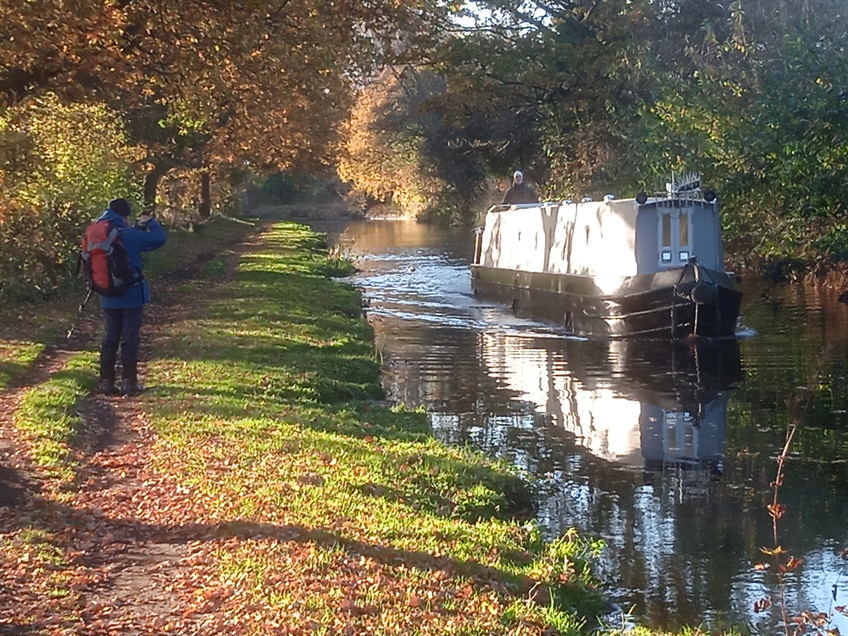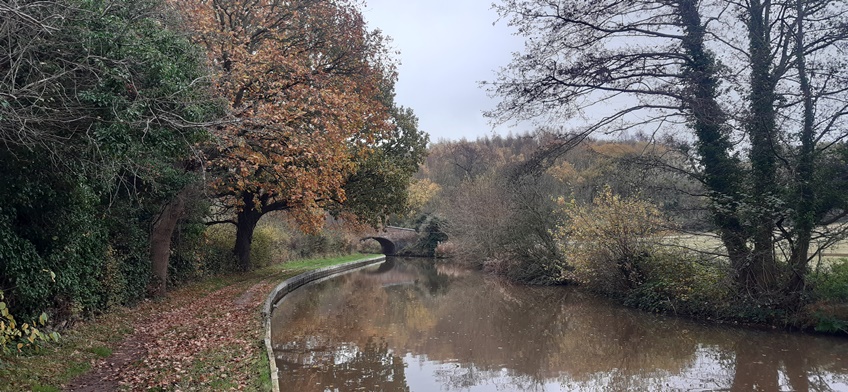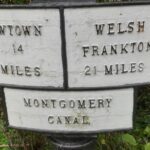My walking companion Peter Gibbs and I had not been sent to Coventry because we were willingly walking there along a wonderfully rural waterway linking the city with the mighty Trent Mersey Canal.
It was while Peter and I were trekking the Trent Mersey on a glorious June afternoon that we first came upon the Fradley Junction with the Coventry Canal and wondered what future adventures that waterway might unfold.
So now we had returned early on a cold and crisp November morning under crystal clear blue skies to trek the thirty-eight miles into Coventry.
The rising sun shining directly into our faces, set the canal side trees ablaze, casting a golden glow over the millions of autumn leaves carpeting the path ahead and floating on the still waters below.
The Coventry Canal was constructed between 1768 and 1789 to give the rapidly expanding city access to wider markets and to exploit the potential of the Warwickshire coalfields.
Today it is a magnet for narrowboat enthusiasts and it seemed that this sunny morning had tempted shoals of them out from their moorings to cruise the waterway, casting a myriad of reflections as they passed.
Sitting on the stern of his narrowboat Petulla, we came upon retired Somerset tree surgeon Ben who has roamed far and wide around the waterways over the past six years.
He was preparing to make soup and a risotto from a locally grown pumpkin left over from Halloween and would soon be off to a nearby farm for a large jug of milk.
“Members of the local narrowboat fraternity enjoy a real community spirit and that’s what I love about this life,” he said, stopping to greet another skipper passing by.

The late afternoon shadows were lengthening as we reached the small canal side town of Fazely where we were staying for the night.
We were made most welcome at the inn and after a pleasant evening, a pub supper and a good night’s rest, we left Fazely under cold and overcast skies, soon to cross a wide reach of the River Tame, a major tributary of the River Trent.
By noon we’d reached Polesworth and ventured into the Bulls Head where we received a warm welcome from a group of locals already partaking in some good crack.
This small village was renowned in the 16th century as the largest literary gathering outside London and its history is now marked by the Polesworth Poetry Trail.
That afternoon before heading out into open country with some fine views of distant hills, we came upon a contractor’s barge with its three-man crew.
They were busy cutting and chipping overhanging branches to keep the waterway clear on behalf of the Canal and River Trust who employ teams doing essential maintenance work around the network during the winter months.
Reaching the bustling canal side town of Atherstone where we were overnighted at the Red Lion Hotel, we treated ourselves to large pot of tea with cake in the former coaching inns comfortable lounge.
Early the following morning we quickly came upon the impressive Atherstone flight of eleven locks which, covering two miles, lift the waterway eighty feet above the Leicestershire plain.
Not far beyond we reached Hartshill, lying within the old Roman Settlement of Mancetter, and it was believed to be here in AD 60 that a highly disciplined Roman legion completely destroyed Boudiccas eighty thousand strong rebel army whereupon the Iceni heroine took poison.
The canal now weaved its way for miles around the edge of higher ground with some fine views towards open country below.
We were now passing through an area where extensive quarrying provided millions of tonnes of granite and quartz traffic for the canal.
One highly visible reminder of those industrial days is Mount Jud a conical mountain of rock spoil rising 426 feet above sea level and named after the quarry owning Judkins family.
Passing through the outskirts of Nuneaton, we were quickly out into open country again and soon to have a literary surprise.
For diverting off the canal and walking a mile along a country lane we came upon Griff House, now a Premier Inn and Beefeater Restaurant, but formerly the home of Victorian author George Eliot who lived there until she was twenty-one.
The sun was just rising over the horizon into a clear blue sky as we regained the canal the following morning for our final eight miles walk to the canal basin in the heart of Coventry,
After passing quiet Marston Junction with the Ashby Canal, we came upon on the far more important Hawkesbury Junction with the Oxford Canal, which we’d walked some years earlier.
Both the Coventry and Oxford canals share the distinction of being the two oldest in the country.
Not far from journeys end we came upon a group of the Canal and River Trust’s Coventry Five and a Half Towpath Task Force volunteers.
Covering the canal from the Coventry Basin to Hawkesbury Junction, they carry out general maintenance tasks including towpath repairs and litter picking.
Surprisingly the canal remains a green and pleasant walk right into the heart of the city and there at the end of the towpath was a cafe.
Looking back on the walk over an early lunch, we pondered over the many sights we had seen along the way, including a large white love heart with two pictures of the Eiffel Tower.
But what romantic story that had to tell, I guess we shall never know.
Nigel Heath, Travel Writer.
Fact file.
Pearson’s Canal Companion South Midlands was essential for planning and following this three and a half day walk.
We stayed overnight at the Amber House in Alrewas, the Fazeley Inn, Fazeley, The Red Lion in Atherstone and The Premier Inn, Coventry Road for which we left the canal in open country at Bridge Seventeen.




